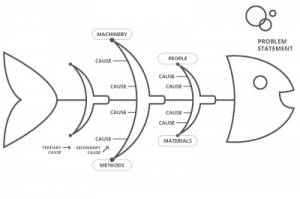



Fishbone diagrams are typically worked right to left, with each large "bone" of the fish branching out to include smaller bones containing more detail.Fishbone diagrams are used in the "analyze" phase of SixSigma's DMAIC (define, measure, analyze, improve, control) approach to problem solving. Examples could be Knowledge, lack of standards, tight schedule, lack of reviews etc. The root cause categories to be identified. Causal relationships are relationships between two or more factors. A specific defect could be the problem with a total number of counts. Cause and effect diagrams are commonly used to illustrate causal relationships. The design of the diagram looks much like a skeleton of a fish. Cause-and-effect diagrams are used to identify the possible effects of quality defects and errors. After the group has brainstormed all the possible causes for a problem, the facilitator helps the group to rate the potential causes according to their level of importance and diagram a hierarchy. The cause and effect diagram tool combines brainstorming and mind mapping to. Sometimes called a fishbone or cause and effect diagram, an Ishikawa diagram is used by management to determine the reasons behind variations, defects, or failure within a specific process. Kaoru Ishikawa, a Japanese quality control expert, is credited with inventing the fishbone diagram to help employees avoid solutions that merely address the symptoms of a much larger problem.A fishbone diagram is useful in brainstorming sessions to focus conversation. An Ishikawa diagram is one of the main tools used in root cause analysis. Possible contributing causes are listed on the. Get PMP Project Management Professional Exam: Review Guide now with the OReilly. The problem or effect is displayed at the head or mouth of the fish. This diagram is also called a fishbone diagram or an Ishikawa diagram. Fishbone diagram is a visual way to look at cause and effect. A fishbone diagram, also called a cause and effect diagram or Ishikawa diagram, is a visualization tool for categorizing the potential causes of a problem in order to identify its root causes.Dr. A Cause and effect diagram or Fishbone diagram helps in brainstorming to identify the possible causes of the problem, and in sorting these ideas into useful categories.


 0 kommentar(er)
0 kommentar(er)
